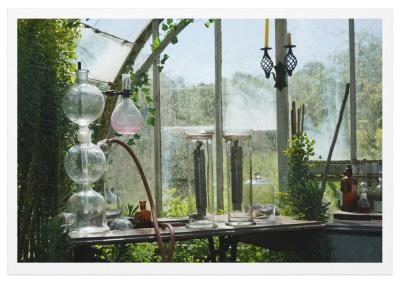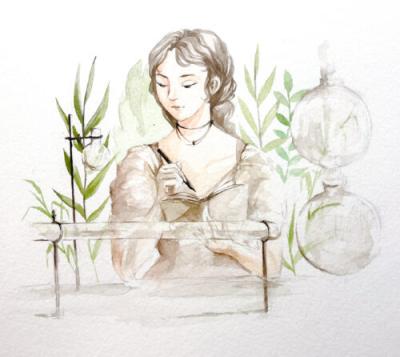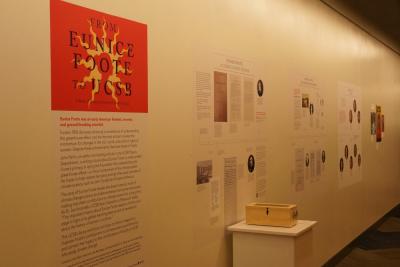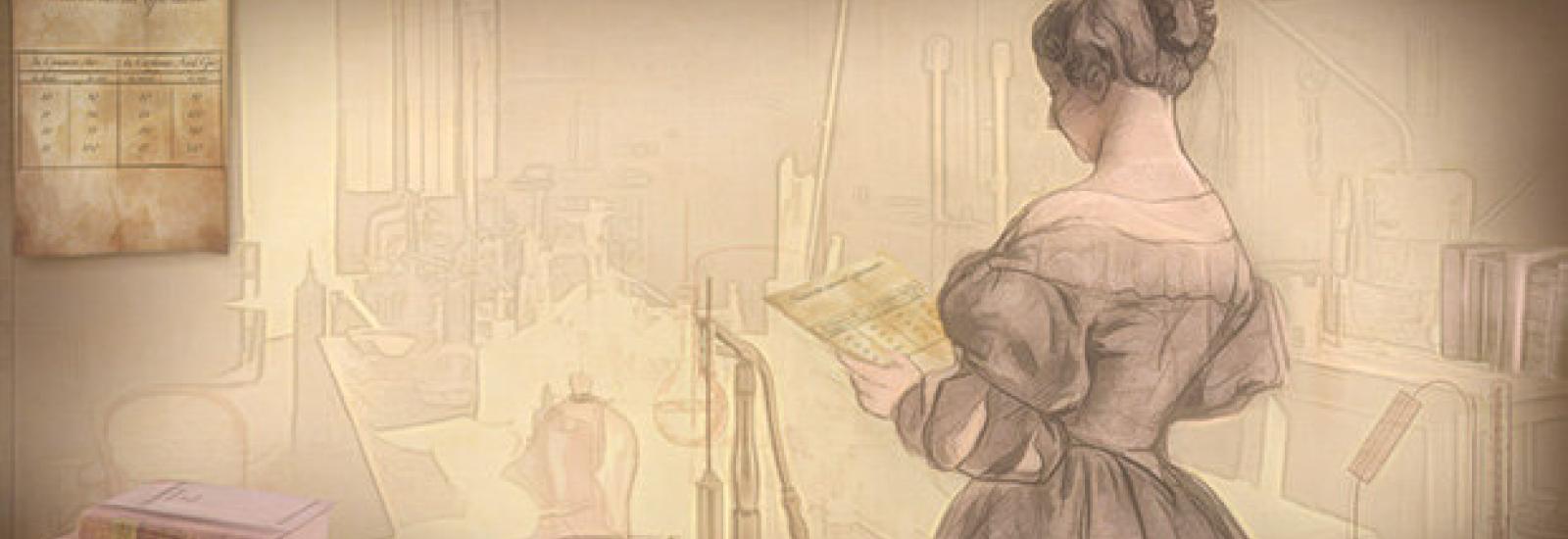Artistic representation of Eunice Newton Foote. Drawing by Carlyn Iverson, NOAA Climate.gov.
— HISTORY CORNER —
Eunice Newton Foote: Climate Science Pioneer
By Savannah Stearmer
Generally, the credit for the discovery of what we now call the greenhouse effect has been given to Irish scientist John Tyndall (1820-1893). In 1861, Tyndall published a paper demonstrating the interactions between infrared light and various gases, and eventually established himself as the father of climate science. Tyndall’s work was undoubtedly influential in the scientific community, but the credit for being first actually belongs to someone else: an amateur scientist, women’s rights campaigner, and inventor who published her own paper titled “Circumstances affecting the heat of the Sun's rays” two years before Tyndall had even begun his research.[i] Her name is Eunice Newton Foote, and until 2011 she had been completely forgotten by history.[ii]
Her research
In the mid-1800s, the fledgling scientific community in the United States held a particular interest in the widely distributed fossils of tropical flora and fauna around the globe and the presence of coal deposits at high latitudes, as well as a number of competing theories as to their origin.[iii] Some believed that the high latitude coal was the result of plate tectonics and continental drift while others blamed residual heat from Earth’s formation. Some even guessed that a higher concentration of carbon dioxide could have been the cause but incorrectly supposed that CO2 would have acted as “plant food” and encouraged growth while water vapor retained heat. No one thought CO2 itself could be linked to warming and none, before Foote, sought to test any of their theories.[iv]

Foote’s experiment stemmed from the hypothesis that the composition and density of the atmosphere is the cause of global warming.[v] To test this, she constructed a simple yet elegant experiment which measured the atmospheric temperature of glass cylinders placed out in the sun using three different variables: air density, air humidity, and concentration of CO2. She concluded that lower density air retained less heat, high moisture retained more, and carbon dioxide retained the most heat of the three.[vi] Based on these results, she concluded that the tropical past must have been warmer due to increased levels of CO2 in the atmosphere which would have directly led to the warming of the Earth. This paper is the earliest known experimentally verified conclusion about the relationship between CO2 and climate change — which marks Eunice Newton Foote as a pioneer in the field of climate science.[vii]
Foote’s 1856 paper was presented by Joseph Henry, the first secretary of the Smithsonian Institute, at the American Association for the Advancement of Science (AAAS). Both contemporary and modern writers agree this was an instance of sexism since Foote was apparently unable to present the paper herself. However, this does mean that one of the foremost scientists in the United States was aware of and willing to be associated with her work.[viii] At a time when direct, interpersonal connections were one of the few ways a scientist could gain traction, Foote’s association with Joseph Henry was potentially invaluable.[ix]
Foote’s scientific work is distinguished on several other fronts as well. For example, her 1856 paper is the first written by a woman to be read at a major scientific convention in the United States. Moreover, across the entire 19th century, only 16 papers on physics were written by women. Two of these were written by Foote, her 1856 paper on atmospheres and her 1857 paper on electricity. Foote was also the only woman in the 19th century to publish before 1889. In fact it would be thirty years before another woman was published![x]
Considering the scope of her own discoveries as well as her status as a pioneering woman scientist, it is a shame that the legacy of Eunice Newton Foote was left unknown for so long. It’s vital to discuss and honor her life and legacy now.
Her Life
Eunice Newton Foote was born July 17, 1819 in Goshen, Connecticut.[xi] Her family later moved to Seneca Falls, New York, where she attended Troy Female Seminary, and where she had access to the cutting edge of scientific education in the United States through the Female Seminary’s connection with what would become the Rensselaer Polytechnic Institute.[xii]

In 1841, Eunice Newton married Elisha Foote, a judge, scientist, mathematician and inventor. They raised two daughters together, and it’s likely that they also worked together since Elisha also published a scientific paper on the sun’s heating powers, similar to Eunice’s work.[xiii] Foote was one of five women appointed by the 1848 Seneca Falls Convention to prepare its proceedings for publication[xiv], and both Eunice and Elisha signed the seminal Declaration of Sentiments. Eunice Foote also invented a skate without straps, a rubber sole for shoes to prevent squeaking and an improved paper making machine.
In the midst of pioneering social and technological advancement, Foote was also a published scientist. In the United States, her first paper “Circumstances affecting the heat of the sun's rays” was praised by the Scientific American, which published an article titled “Scientific Ladies—experiments with condensed gases” that applauded Foote’s experiment for finally settling the debate on how Earth was warmer in its past. Her paper was also published in the American Journal of Science and Arts directly alongside her husband’s paper.[xv]
One journal that did not publish her research was the Great Britain based Philosophical Magazine, although the journal did publish her husband’s article. Coincidentally, John Tyndall was one of four editors for Philosophical Magazine at the time which has caused some to speculate about whether Tyndall might have stolen Foote’s work. However, the evidence for this is entirely circumstantial. There is no way to prove that Tyndall himself selected Elisha Foote’s paper for publication, no way to prove he even saw Foote’s article let alone read it, and analysis of his letters and laboratory notes from the time fail to indicate any sort of foul play.[xvi] Moreover, if Tyndall happened to have been the editor who reviewed both Footes’ papers, it is entirely possible that he saw the name “Eunice” at the top of one and dismissed it out of hand.[xvii]
Her Legacy

Since her rediscovery, Eunice Newton Foote has been justifiably praised for her research. In 2019, the University of California, Santa Barbara hosted an exhibit titled “From Eunice Foote to UCSB: A Story of Women, Science and Climate Change”. The American Geophysical Union has also honored Foote by creating The Eunice Newton Foote Medal for Earth-Life Science whose first recipient was awarded in 2022.
Today, we can and should understand all of the barriers Foote faced as an amateur scientist, an American, and a woman, and we can praise her engagement with the fledgling scientific community around her and her ability to draw conclusions from her experiments. After being lost for decades, we can finally place Eunice Newton Foote front and center as the first to understand global warming as we understand it today.
End Notes
[i] Jackson, R. (2019). Eunice Foote, John Tyndall and a question of Priority. Notes and Records of the Royal Society, 74(1), 105-18. https://doi.org/10.1098/rsnr.2018.0066
[ii] Bell, Alice. (2021). Our Biggest Experiment: An Epic History of the Climate Crisis. Counterpoint.
[iii] Oritz, J. D. & Jackson, R. (2020). Understanding Eunice Foote’s 1856 experiments: heat absorption by atmospheric gases. Notes and Records of the Royal Society, 76(1), 67–84. https://doi.org/10.1098/rsnr.2020.0031
[iv] Maxwell, J. (2022, December 9). Geology professor and science historian co-author article exploring Eunice Foote’s climate experiments from 1856. Kent State University College of Arts & Sciences. https://www.kent.edu/cas/news/geology-professor-and-science-historian-co-author-article-exploring-eunice-footes-climate
[v] Oritz, J. D. & Jackson, R. (2020). Understanding Eunice Foote’s 1856 experiments: heat absorption by atmospheric gases. Notes and Records of the Royal Society, 76(1), 67–84. https://doi.org/10.1098/rsnr.2020.0031
[vi] Bell, Alice. (2021). Our Biggest Experiment: An Epic History of the Climate Crisis. Counterpoint.
[vii] Oritz, J. D. & Jackson, R. (2020). Understanding Eunice Foote’s 1856 experiments: heat absorption by atmospheric gases. Notes and Records of the Royal Society, 76(1), 67–84. https://doi.org/10.1098/rsnr.2020.0031
[viii] Oritz, J. D. & Jackson, R. (2020). Understanding Eunice Foote’s 1856 experiments: heat absorption by atmospheric gases. Notes and Records of the Royal Society, 76(1), 67–84. https://doi.org/10.1098/rsnr.2020.0031
[ix] Jackson, R. (2019). Eunice Foote, John Tyndall and a question of Priority. Notes and Records of the Royal Society, 74(1), 105-18. https://doi.org/10.1098/rsnr.2018.0066
[x] Maxwell, J. (2022, December 9). Geology professor and science historian co-author article exploring Eunice Foote’s climate experiments from 1856. Kent State University College of Arts & Sciences. https://www.kent.edu/cas/news/geology-professor-and-science-historian-co-author-article-exploring-eunice-footes-climate
[xi] Schwartz, J. (2020, April 21). Overlooked no more: Eunice Foote, climate scientist lost to history. The New York Times. https://web.archive.org/web/20220524184702/https:/www.nytimes.com/2020/04/21/obituaries/eunice-foote-overlooked.html
[xii] Perlin, J. (2019, July 30). A “Foote-note” on the hidden history of climate science: why you have never heard of Eunice Foote. Resilience. https://www.resilience.org/stories/2019-07-30/a-foote-note-on-the-hidden-history-of-climate-science-why-you-have-never-heard-of-eunice-foote/
[xiii] Sorenson, R. P. (2011, January 31). Eunice Foote’s pioneering research on CO2 and climate warming. Search and Discovery. https://www.searchanddiscovery.com/pdfz/documents/2011/70092sorenson/ndx_sorenson.pdf.html
[xiv] Wellman, J. (2004). The Road to Seneca Falls: Elizabeth Cady Stanton and the First Woman’s Rights Convention. University of Illinois Press. muse.jhu.edu/book/18626.
[xv] Jackson, R. (2019). Eunice Foote, John Tyndall and a question of Priority. Notes and Records of the Royal Society, 74(1), 105-18. https://doi.org/10.1098/rsnr.2018.0066
[xvi] Jackson, R. (2019). Eunice Foote, John Tyndall and a question of Priority. Notes and Records of the Royal Society, 74(1), 105-18. https://doi.org/10.1098/rsnr.2018.0066
[xvii] Bell, Alice. (2021). Our Biggest Experiment: An Epic History of the Climate Crisis. Counterpoint.

